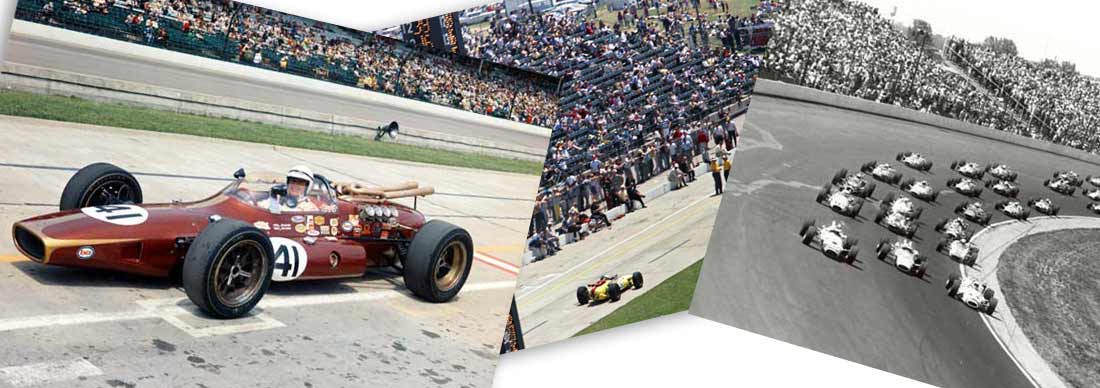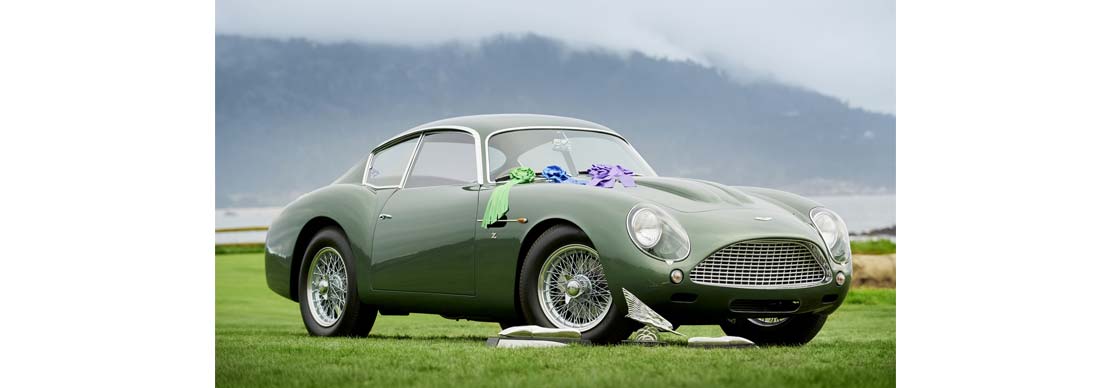
BRP’s Indianapolis Swan Song - Part 5
By Ian Wagstaff
Even though BRP itself was no more, the Indy cars continued to appear on the USAC trail. George Bryant’s crew chief Howard Gilbert modified them for the 1966 season with Quinn Epperly adding new bodywork. Boyd again drove one of the, now yellow, cars hitting the wall in turn one after five laps. However, that year’s first lap, multiple wreck which saw a third of the field drop out, meant he was still classified as high as 22nd.. Bobby Johns, who had been Jim Clark’s Lotus team mate at Indianapolis the previous year, failed to complete a qualifying run in the other car.

Above: The start of the 1966 Indianapolis 500, with Jimmy Boyd’s BRP in the middle of the fifth row. (Indianapolis Motor Speedway)
A film, made for Firestone about the 1966 Indy 500, features Boyd smacking the wall and being towed to the centre of the track. ‘George Salih’s beautiful speed creation joins the pile of battered cars,’ says the voice of famed Indy radio commentator Sid Collins. Given the fact that the car had been ‘created’ in Highgate, the observation does appear a trifle parochial, but then Collins’s script also refers to eventual winner Graham Hill as the former ‘European road race champion’. British cars and drivers may have won the 500 for two years running and a whole new wave of Europeans were on their way as part of a movement in which BRP can be said to have been one of the pioneers but, in 1966, the Indianapolis 500 was still very much a US of A event.
George Bryant again entered the two cars for the 1967 Indianapolis 500, one of them now painted brown and gold for Missouri-born Carl Williams, the other still in yellow for New Zealander Chris Amon, a Grand Prix driver and the winner of the previous year’s Le Mans 24-Hour race. Williams went a lot further than Boyd the previous season and ran as high as eighth place. However, on the 177th lap he was part of an incident on Turn Three, which also involved the Gerhardts of Bob Veith and Bud Tinglestad. While the latter continued unscathed, Williams and Veith were left with damage to their nosecones.

Above: Chris Amon leaves the pits in a vain attempt to qualify for the 1966 Indianapolis 500. (Indianapolis Motor Speedway)
Williams slowly headed for the pit, where his team removed the offending nose by a method that can only be described as brute force and ignorance. ‘It appears that a giant can opener should be standard equipment in the pits,’ remarks Sid Collins in Firestone’s film of the 1966 race. He also observes that the nosecone being violently removed is ‘the same as was used as a mould for Chris Amon’s damaged car’, the New Zealander, as we will see, having failed to qualify the second BRP after a crash.

Above: The best result for a BRP at Indianapolis was with Carl Williams in 1967. (Indianapolis Motor Speedway)
The Gerhardts had not finished with Williams: as A J Foyt headed for the chequered flag so Bobby Grimm’s Gerhardt broke a half-shaft and spun. Williams and Chuck Hulse, who was driving the Lola in which Graham Hill had won the year before, were caught up in the spin and hit the wall. Foyt’s Coyote threaded past the already lapped cars and won. Ultimately, Williams was credited with 189 laps and classified in 10th place, the highest any BRP driver was to achieve at Indianapolis.
Amon, though, never even made it to the starting grid. There was a problem with the front end of the car during practice and the New Zealander, recalled Howard Gilbert, was ‘spooked’. Up to this point Gilbert had been impressed by Amon’s undoubted talent, reckoning him potentially among the quickest drivers he had worked with. However, the last thing any driver wants at Indianapolis is to lack confidence in his mount’s handling. Although Gilbert believed he resolved the problem, Amon was unhappy about the car when he returned to the track for Bump Day, as the final period of Indy 500 qualifying is called. That year it was particularly fraught. Three men who had been, or were to be, Formula One champions - the previous year’s 500 winner Graham Hill, Jackie Stewart and Jochen Rindt - only just avoided the cut. Amon failed, having hit the wall which resulted in extensive damage to the tub skins.
The number 41 BRP that was driven by Masten Gregory, Johns and Williams at the Speedway also raced elsewhere, running at Atlanta and in Fuji, Japan in 1966, driven by Boyd and Williams respectively. Boyd finished seventh in the Atlanta 300, the best finishing position for a BRP Indy car, while Williams retired from the Japanese race, the only time that a BRP-built car had raced in Asia, with a broken fuel pump. Bob Harkey also practised the other BRP at Fuji - where Jackie Stewart scored another victory for the British in his Lola - but suffered a burned bearing and non-started. Harkey also tried to qualify for the race at Phoenix that November, but was deemed too slow.
The following year ‘number 41’ competed twice on the fearsome Langhorne circle, at the Indianapolis Raceway Park (a few miles north west of the city and not to be confused with the Indianapolis Motor Speedway), at Milwaukee and twice in Canada, at Mosport and at St Jovite. Each time Williams was the driver, his best position being an eighth in the IRP 150-mile race. At the Langhorne 100 he retired after 66 laps with poor handling but went on to finish 11th the following month in the Langhorne 150.

Above: This would appear to be a Prestone publicity shot of Jimmy Boyd’s BRP taken in 1966. (Courtesy Thomas Acker)
At Mosport, he finished 15th in the first heat and, again, 15th in the rain-curtailed second heat. The St Jovite event was also one of two halves, Williams coming in 14th, a lap down on the leader in the first heat, but retiring with a broken valve in the second. Milwaukee must have had something against Williams’s BRP. In practising for the June 4 Rex May Classic, he crashed the car in turn one and failed to start the race. He did make it to the grid for the August 20 meeting, the Tony Bettenhausen 200, but, after 30 laps, he again crashed the car, which caught fire. It was the end of the racing road for the Indy BRPs.
While ‘number 41’ continued to race, the other car underwent a torrid time. Following Amon’s crash at Indianapolis, Howard Gilbert had stripped and discarded the skins from the bulkhead of the car and saved anything that was not bent. California-based Gilbert was to go on to use some of the now obsolete BRP parts from this car, such as wheels, steering racks, hubs and brake discs (rotors), to create two new cars based on a Brabham BT12 chassis and called Cheetahs.
These raced a number of times during 1968 and into the 1970s. Neither was able to qualify for the 1968 Indianapolis 500. Masten Gregory was one of their nominated drivers that year but was replaced by Rick Muther when he was unable to top 160mph. Muther then crashed during his qualifying run. Amongst the other drivers of the cars was George Follmer who took a surprise victory at Phoenix in 1969.
Fast forward to 2019 and Steve Francis, then owner of a Cheetah observed, ‘While cleaning up a spare set of Halibrand wheels that came with my Howard Gilbert-built 1967 Cheetah, a BRP stamp was spotted on one of the front wheels. Given that my set are 8.50 and 9.50 inch in width, they might be from the 1966-67 seasons. I've heard that Gilbert used some BRP parts on the Cheetah builds.’
Concluding part in next issue of Driving Pleasure.
Books by Ian Wagstaff
Other articles by Ian:
BRP’s Indianapolis Swan Song - Part 1
BRP’s Indianapolis Swan Song - Part 2
BRP’s Indianapolis Swan Song - Part 3
BRP's Indianapolis Swan Song - Part 4
BRP's Indianapolis Swan Song - Part 6






1 comment
Dear Ian,
Would
Like to contact you re the exceptional cars series for a potential writing an additional title
Regards
Elad Shraga
Leave a comment
This site is protected by hCaptcha and the hCaptcha Privacy Policy and Terms of Service apply.